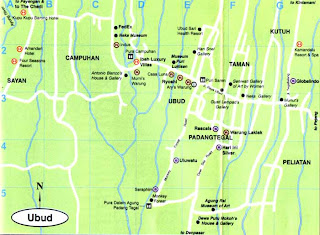
Location
Ubud is a town on the Indonesian island of Bali in Ubud District, located amongst rice paddies and steep ravines in the central foothills of the Gianyar regency. One of Bali's major arts and culture centres, it has developed a large tourism industry.
Ubud has a population of about 8,000 people, but it is becoming difficult to distinguish the town itself from the villages that once surrounded it.
Town Orientation And Accomodation
The main street is Jalan Raya Ubud (Jl. Raya means main road), which runs east-west through the center of town. Two long roads, Jalan Monkey Forest and Jalan Hanoman, extend south from Jl. Raya Ubud. Puri Saren Agung is a large palace located at the intersection of Monkey Forest and Raya Ubud roads. The home of Tjokorda Gede Agung Sukawati (1910-1978), the last "king" of Ubud, it is now occupied by his descendants and dance performances are held in its courtyard. It was also one
 of Ubud's first hotels, dating back to the 1930s.
of Ubud's first hotels, dating back to the 1930s.The Ubud Monkey Forest is a sacred nature reserve located near the southern end of Jalan Monkey Forest. It houses a temple and over 200 long-tailed macaque (Macaca fascicularis) monkeys.
Tourism to Ubud has a focus on culture, yoga and nature. In contrast to the main tourist area in southern Bali, the Ubud area has forests, rivers, cooler temperatures and less congestion although traffic has increased dramatically in the 21st century. A number of smaller "boutique"-style hotels are located in and around Ubud, which commonly offer spa treatments by the foothills or treks up Ubud's mountains.
The Moon of Pejeng, in nearby Pejeng, is the largest single-cast bronze kettle drum in the world, dating from circa 300BC. It is a popular
destination for tourists interested in local culture, as is the Goa Gajah, or 'Elephant Cave', complex.
The town of Ubud has few sights within walking distance, and you'll need some form of transport to get to the temples in the vicinity. The easiest option is to join a tour, or just charter a taxi/bemo for a few hours.
* Botanic Garden, Kutuh Kaja, +62 361 970 951, [1]. The recently opened Botanic Garden is a wonderful way to spend a few hours walking around and exploring the valley that it fills. It is best to go in the morning and avoid the afternoon heat.
* Monkey Forest, south end of Jl. Monkey Forest; [2]. A forest full of ravenous monkeys, so don't bring any food or risk bites and rabies injections. Stroll through to find Pura Dalem Agung Padangtegal, a Temple of the Dead.
* Museum Puri Lukisan (Museum of Fine Arts), Jl. Raya Ubud (spot the sign and cross the bridge to enter), [3]. Three buildings showcasing traditional and modern Balinese art. The displays are musty and English labeling is a little spotty, but some of the works, particularly the carvings, are quite amazing. Entrance Rp 20,000.
* Museum Rudana, Jl. Cok Rai Pudak 44, Peliatan, Ubud, [4]. Ph : Tel: +62 361 975779, Fax : +62 361 975091. E-mail: rudana@senatorrudana.com. Run by its owner and sole artist Nyoman Rudana.

* Seniwati Gallery of Art by Women, Jalan Sriwedari 2B, +62 361 975485, Banjar Taman, Ubud, [5]. The Seniwati Gallery features art by women; "Seni" is Indonesian for "art" and "Wati" means "women".
All of the following temples cost Rp. 6000/3000 adults/children, and can be reached by taking bemos towards Tampaksiring. Everybody must wear a sash, available at the entrance for a Rp. 1000 donation, and either long pants or a sarong (from Rp. 5000 from hawkers).
Elephant Cave (Goa Gajah)
Elephant Cave (Goa Gajah)
* Goa Gajah (Elephant Cave), 3 km east from Ubud. A popular little excursion from Ubud, the centerpiece here is a cave, whose entrance is an ornately carved demon's mouth. Inside are some fragmentary lingam and yoni (phallus and vagina) statues, as well as a statue of Ganesha. Statues stand guard around pools near the entrance and a little path leads to a waterfall, rice fields and some Buddhist stupa fragments.
* Gunung Kawi (Poet Mountain), Tampaksiring, 18 km northeast from Ubud. Entrance fee is Rp. 6000, sarong is rented for free. Dating from the 11th century, this is presumed to be the burial complex of King Anak Wungsu and his many wives. Reached by climbing down 371 steps, the location at the bottom of a steep valley lined with paddy fields is stunning. The smaller complex on the south side of the river is presumed to be for the king's wives, while the larger complex is thought to be for the King himself and perhaps his concubines. You must take off your shoes before entering into the central pura complex. About one km downstream there are further tomb cloisters. On the way back up, take a break at Cafe Kawi, which has cold drinks (Rp. 10,000 & up) and fresh breezes (free).
* Tirta Empul, Tampaksiring, 20 km northeast from Ubud. One of the holiest temples on Bali, built around hot springs that now bubble eerily in the central courtyard. Balinese themselves come here to bathe and purify themselves physically and spiritually, and during Galungan the sacred barong masks are bathed here. The complex dates to 960, but the present buildings are all modern reconstructions.






